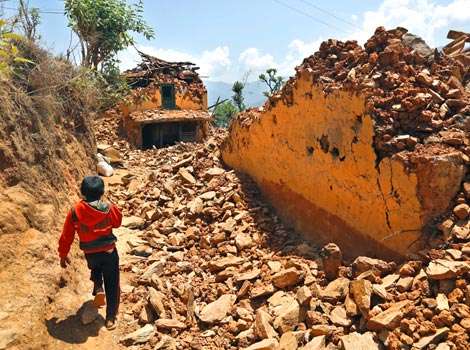June 19, 2015
A dramatic increase in the rate of earthquakes in the central and eastern US since 2009 is associated with fluid injection wells used in oil and gas development, a new study has claimed.

Nepal, earthquake: A Nepalese boy runs past houses destroyed in the April 25 earthquake in Pauwathok village, Sindhupalchok district, Nepal. (AP Photo)
June 19, 2015
A dramatic increase in the rate of earthquakes in the central and eastern US since 2009 is associated with fluid injection wells used in oil and gas development, a new study has claimed.

Nepal, earthquake: A Nepalese boy runs past houses destroyed in the April 25 earthquake in Pauwathok village, Sindhupalchok district, Nepal. (AP Photo)
The number of earthquakes associated with injection wells has skyrocketed from a handful per year in the 1970s to more than 650 in 2014, according to University of Colorado Boulder doctoral student Matthew Weingarten, who led the study. The increase included several damaging quakes in 2011 and 2012 ranging between magnitudes 4.7 and 5.6 in Prague, Oklahoma, Trinidad, Colorado, Timpson, Texas, Guy and Arkansas, researchers said.
"This is the first study to look at correlations between injection wells and earthquakes on a broad, nearly national scale," said Weingarten. "We saw an enormous increase in earthquakes associated with these high-rate injection wells, especially since 2009, and we think the evidence is convincing that the earthquakes we are seeing near injection sites are induced by oil and gas activity," Weingarten said.
The researchers found that "high-rate" injection wells – those pumping more than 300,000 barrels of wastewater a month into the ground – were much more likely to be associated with earthquakes than lower-rate injection wells.
Injections are conducted either for enhanced oil recovery, which involves the pumping of fluid into depleted oil reservoirs to increase oil production, or for the disposal of salty fluids produced by oil and gas activity, said Weingarten.
The team assembled a database of roughly 180,000 injection wells in the study area, which ranged from Colorado to the East Coast.
More than 18,000 wells were associated with earthquakes – primarily in Oklahoma and Texas – and 77% of associated injection wells remain active, researchers said.
Of the wells associated with earthquakes, 66% were oil recovery wells, said CU-Boulder Professor Shemin Ge. But active saltwater disposal wells were 1.5 times as likely as oil recovery wells to be associated with earthquakes.
"Oil recovery wells involve an input of fluid to 'sweep' oil towards a second well for removal, while wastewater injection wells only put fluid into the system, producing a larger pressure change in the reservoir," Ge said.
Enhanced oil recovery wells differ from hydraulic fracturing, or fracking wells, in that they usually inject for years or decades and are operated in tandem with conventional oil production wells, said Weingarten. In contrast, fracking wells typically inject for just hours or days.
The team noted that thousands of injection wells have operated during the last few decades in the central and eastern US without a ramp-up in seismic events.
"It's really the wells that have been operating for a relatively short period of time and injecting fluids at high rates that are strongly associated with earthquakes," added Weingarten.
The research appears in the journal Science.
Courtesy: HT
















































































































